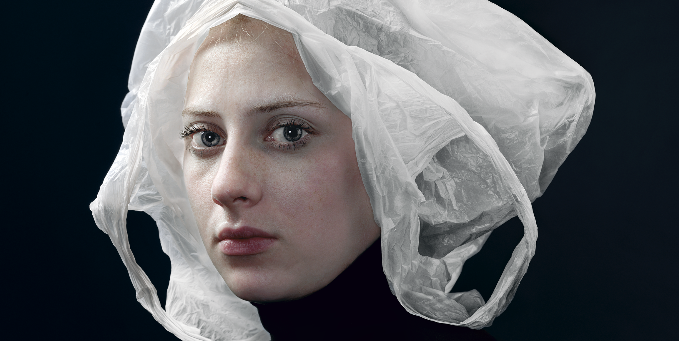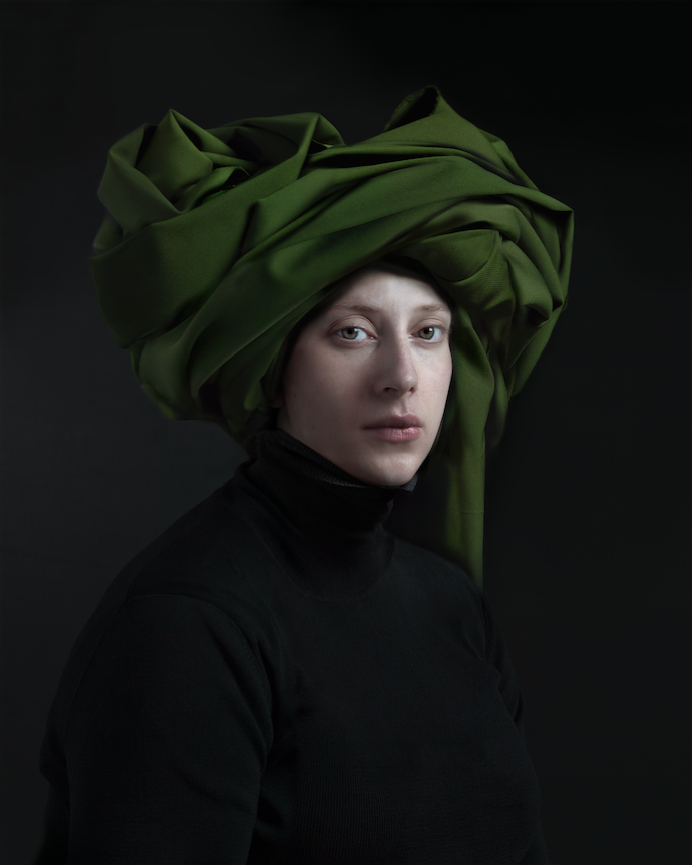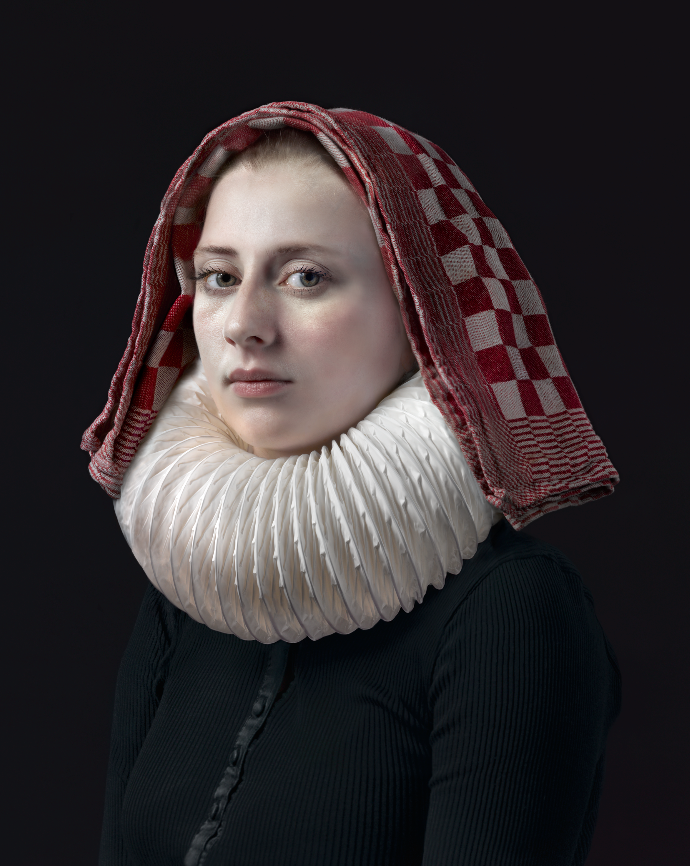This Photographer Is a Modern Day Dutch Master

At first, the Dutch photographer Hendrik Kerstens’s portraits-shot over the course of nearly 25 years, from 1995 to today-look eerily familiar: A dignified and austere young woman, her face pale as the moon and her nose proudly aquiline, emerges in three-quarter profile from deep shadow, dressed like a ripe young burgher of the Dutch Golden Age. She looks here like Johannes Vermeer’s Girl with a Pearl Earring, there like Petrus Christus’s Portrait of a Young Girl, at other times like Jan van Eyck’s Portrait of a Man in a Red Turban.
But Kertsens’s trademark riffs on the Old Masters, which he calls “the echoes of visual memories,” are twisted into a kind of sight gag: Upon closer inspection, van Eyck’s turban reveals itself to be a towel, Christus’s conical hat a lampshade. Nuns’ habits, conquistadors’ helmets, and noblewomen’s headdresses are fashioned from toilet paper, soda cans, Bubble Wrap, and plastic bags.
Where Vermeer’s Girl wore a pearl, for millennia a symbol of purity, Kerstens’s young woman wears household trash. The distortion is both a deadpan joke and a deadly serious ecological rallying cry about consumerism, waste, and the irreversible harm we’re visiting upon the planet the Old Masters bequeathed us.

But more than this environmental concern or their impressive technical skill-crisp, tight, intense chiaroscuros, they’re like two decades of class pictures by Rembrandt-what really elevates these portraits above a clever historical gimmick is that Kertsens is not only the darkroom Vermeer, but also the Dutch Sally Mann: The woman in all of his pictures is the photographer’s daughter, Paula. Taken in its entirety, then, the series becomes a quarter-century-long meditation on time and familial devotion that mirrors the shifting role of women in the art-historical discourse: from object to subject and, ultimately, presenters of our own image.
Kerstens’s early, more documentary works have something of Mann’s haunting but problematic voyeurism and elicit similar concerns about consent: In one shot, a young Paula stands against a black backdrop, shirtlessly cradling a broken arm, evoking Mann’s Damaged Child. In another, she sits in the bath, her small head barely visible above the rim. Closely cropped, the shot corners her; she looks out defiantly. In another still, she perches on a chair in her bathing suit and yellow swim cap, clutching hands that seem to hold invisible worry beads. The chair, isolated against a white wall, is like a pedestal.

“Her posture and look betray some trepidation,” Kerstens tells me. “As if from this moment she is preparing to dive into an unknown future.” Later, glowering and nursing a blistering sunburn against a blue background, Paula looks like the painful aftermath of one of Rineke Dijkstra’s idyllic seaside shots: Unlike those by Mann, Kerstens’s pictures of his child are never portraits of unfettered youth.
Paula, uncommonly serious, seems not only aware but also wary of both her father’s gaze and ours-quick to meet and parry them with her own. A sullen, protective preteen, she turns her body away from us, crosses her arms over her budding chest, a portrait of awkwardness and defiance.
But as Paula ages and Kerstens shifts from documentarian to storyteller, her back straightens and her gaze grows sure. Her expression remains closed, but now it’s frank and proud. An art historian herself, she contributes to the staging of her images. Her stance may be modeled on 17th century paintings, but her countenance becomes that of a Greek bust. Eventually, she acts as de facto press agent and interpreter, molding and communicating a joint vision.
“First we started with documentary photography,” Kerstens says. “Then Paula transformed from object to subject. Now we work together as a duo.” As Paula becomes a full participant in her own image making, the echoes are less of Mann and more of Cindy Sherman’s history portraits and Zanele Muholi’s faux–National Geographic series, Somnyama Ngonyama (Hail the Dark Lioness): fierce self-portraits that rewrite the narrative of female objectification.
Indeed, previous girl muses were chaste, inviting, and caught in amber. (Think of Jessie and Virginia Mann, but also of Susan Meiselas’ Prince Street Girls, Mary Ellen Mark’s young hustlers, or Justine Kurland’s free-spirited adolescents. And, of course, of so many young women painted by male artists from Vermeer to Balthus, with their soft eyes, parted lips, and heads turned towards the painter as if caught unawares- girls forever on the cusp.)

Unlike all of them, Paula is allowed to grow up and take charge. Her porcelain face, its features so strikingly similar to those of the Dutch Golden Age, reflects the radiance of her headdresses like Vermeer’s Girl’s mirrored her earring, but the overall effect is less of warmth than of hard truth. The Dutch light, once dewy, now isolates her in a black world and illuminates both her beauty and her flaws: the occasional unevenness of her skin, the sagging at the corners of her mouth, a tiredness in her eyes.
The photography director Kathy Ryan, who has commissioned Kerstens to shoot cultural figures like Laura Linney for the New York Times Magazine, says that “Kerstens photographs the features his sitters have acquired over the years.” [I’d like to include Kathy Ryan because we talked for like 40 minutes and she was excited about Hendrik being profiled.]
In a way, Paula is the sober doppelgänger of the child models we’ve made our fallen muses. Like them, she has literally grown up in the spotlight. Unlike them, however, we know almost nothing about her outside these carefully staged photographs. Paula allows us to look at her, to chart her evolution. But she never really lets us in. At a time when social media has made us all both photographer and model, Paula is the rare subject who doesn’t seem to crave our attention.
And in a society that pressures the young-young women in particular-to curate an image and offer it up for public consumption, Kerstens’s work is a clever contradiction. It both mimics the intentional commodification of 21st-century self-presentation and, through the mediating framework of historical reenactment, rejects it-insisting, in a perverse way, on privacy. Paula and her father have created something as beautiful as it is incongruous: pictures that both arrest and chronicle aging, a portrait that is also a mask. Paula offers us her likeness, but she keeps who she is for herself.
('You Might Also Like',)
